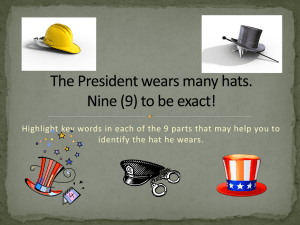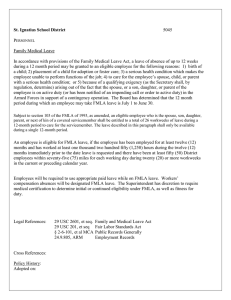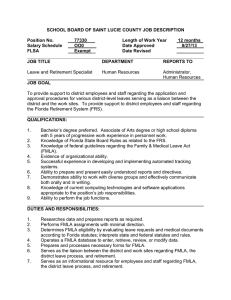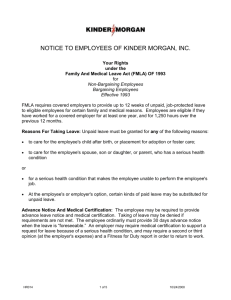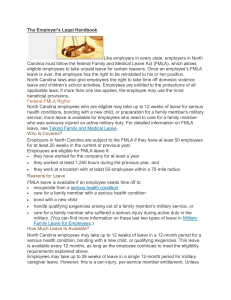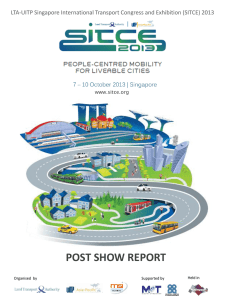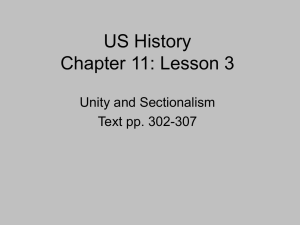Family Medical Leave Act: FMLA
advertisement
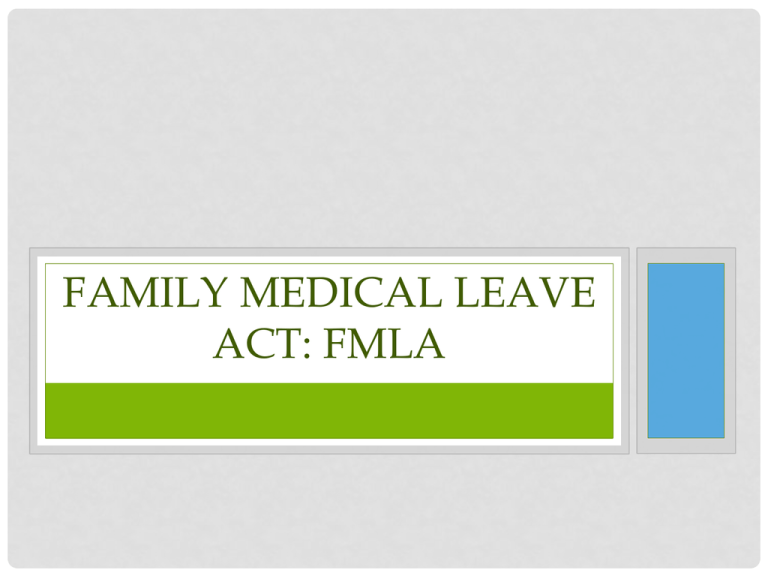
FAMILY MEDICAL LEAVE ACT: FMLA PUBLIC POLICY • This is the end product of governmental decision making. • It is the course of action or inaction taken by governmental entities with regard to an issue or particular set of issues. • It includes regulatory measures, laws, court decisions, and funding priorities concerning a given topic declared by a governmental entity or its representatives. PUBLIC AGENDA • The set of subjects or problems that some significant section of the public believes is important. • Once a topic gets the public’s attention, public opinion is one of the factors that determine whether the issues are addressed through public policy. • Elite opinion, especially through the interest group process, is also important. PUBLIC OPINION • These are the attitudes shared by a significant number of people on matters of government and politics. • Factors that influence public opinion include: • • • • • • • • • Family Education Opinion leaders Mass media Occupation Personal experiences Race Place of residence Etc. POLICY AGENDA • “The list of subjects or problems to which government officials, and people outside of government closely associated with those officials, are paying some serious attention at any given time.” -John W. Kingdon • Remember that House Representatives are elected to two-year terms and Senators are elected to six-year terms. • To provide for stability, the framers of the Constitution staggered elections for Representatives, so that only a third of the House is up for reelection every two years, along with the entire Senate. • Because of this, a “session” of Congress is two years long, the amount of time that membership in the two houses remains the same. • Any bills that fail to reach the President before the end of the session must start the process from the beginning in the next session. • The FMLA’s story stretches across six congresses. FMLA GROUPS • Political PartiesDemocrats • Josiah and Faith • Political PartiesRepublicans • Kasey and Cody • Feminist Groups • Cassie, Sarah and Ashley • Religious Groups • Hannah J., Hannah I. and Jason • Chamber of Commerce Groups (groups promoting and protecting business interests) • Scott and Rachel • Interest Groups • Hannah G., Nathan and Evan • Unions • Katie and Noah YOUR TASK • Look through the FMLA flowcharts looking for instances where your assigned group engages in coalition building, lobbying or tried to influence public opinion • You will be asked to report your findings to the class • Make sure to identify which session of Congress (98th, 99th, etc.) in which the event occured GROUP 1 DISCUSSION QUESTIONS • Why did the issue of employment leave get on the policy agenda? • What was the original issue? • What public policy resulted? • What role did compromise play in the political process? • How did conflict play a role in the political process? • Do you think that conflict over public policy results in better legislation? • How might party politics, personal relationships, and coalition building play a role in the creation of public policy? GROUP 2 DISCUSSION QUESTIONS • In the 98th Congress, Congressman Berman put his support behind a bill he thought would fail. Why would a legislator do this? • What benefits would it have? • What drawbacks might it have? • Why would a legislator vote for a bill he or she did not support? • What role should one’s conscience, political party, and constituents play in how a legislator votes? • How might personal relationships affect the legislative process and resulting public policy? GROUP 3 DISCUSSION QUESTIONS • The opposition to the FMLA called themselves “The Concerned Alliance of Responsible Employers.” How might the names of organizations or legislation influence public opinion and/or members of Congress? • What role do political parties, interests groups, the media, and individuals play in influencing: • • • • The public agenda? Public opinion? The policy agenda? Public policy? • Does the power of each of these groups differ depending on what they are trying to influence (agendas, opinions, policy)? Explain. GROUP 4 DISCUSSION QUESTIONS • In order for it to pass, the Family Medical Leave Act had to be approved by both houses of Congress. Where does most of the work on legislation occur? • What advantages and disadvantages are there in working this way? • How can party leadership influence the policy agenda? • The actual public policy? • How does committee work affect the policy agenda? • The actual public policy? GROUP 5 DISCUSSION QUESTIONS • Given the understanding that nobody expects a bill to pass in its first session, what might be the advantages and disadvantages of having a deliberately slow law-making process? • If a bill managed to pass out of committee in a previous session of Congress, what challenges exist to those who oppose the bill? • Why might the bills in the Senate and House have different language? • What influence would lobbyists have on two different versions of the same bill? • Do lobbyists have a greater influence on public opinion or public policy? Explain.
